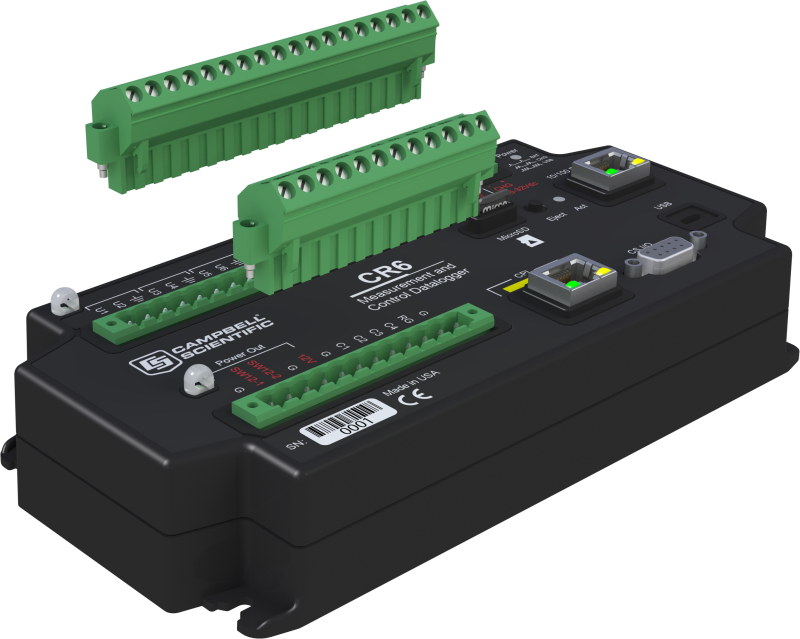 Launched in autumn 2014 the CR6 Measurement and Control Datalogger represented a major step forward in data logger flexibility, measurement quality, performance, and integration. Packed with new capabilities, it retained Campbell Scientific’s trademark rugged design and reliability. The CR6 has rapidly become a popular datalogger for a wide variety of applications. If you rely on dataloggers to do your job, chances are there are some unique new features in this datalogger that you’ll be excited about.
Launched in autumn 2014 the CR6 Measurement and Control Datalogger represented a major step forward in data logger flexibility, measurement quality, performance, and integration. Packed with new capabilities, it retained Campbell Scientific’s trademark rugged design and reliability. The CR6 has rapidly become a popular datalogger for a wide variety of applications. If you rely on dataloggers to do your job, chances are there are some unique new features in this datalogger that you’ll be excited about.
Flexibility
It is fair to say that the CR6 is the most flexible datalogger Campbell Scientific have ever built. Starting with the 12 universal channels that allow connection to nearly any sensor type (e.g., single or differential voltage input, SDI-12, pulse). This removes constraints involved with matching sensors to terminals or not having enough of a specific type of terminal. It gives the CR6 the ability to match more applications, eliminates the use of many external peripherals, allows project needs to evolve without having to swap out the datalogger or add peripherals, and ultimately leads to long-term datalogger re-use and, therefore, maximisation of your datalogging investment.
The terminals are also field-friendly; they can easily be removed for wiring sensors or swapping out the datalogger or sensors. Terminals are lockable, angled, and support larger-gauge wires and even multiple wires.
 With on-board power conditioning and expanded charging options, there is a lot of flexibility in the way you power the CR6: a 12 V battery, 10 to 32 Vdc power supply, UPS with solar panel, UPS with ac-to-dc converter, and even some functionality with power over USB. Batteries and solar panels can be connected directly to the CR6 without the need for a power-conditioning module.
With on-board power conditioning and expanded charging options, there is a lot of flexibility in the way you power the CR6: a 12 V battery, 10 to 32 Vdc power supply, UPS with solar panel, UPS with ac-to-dc converter, and even some functionality with power over USB. Batteries and solar panels can be connected directly to the CR6 without the need for a power-conditioning module.
The CR6 uses the same powerful CRBasic programming language used by other current Campbell dataloggers. This comprehensive programming language allows users to make and store measurements exactly the way they want to. Programs or code snippets used with other Campbell loggers will function on the CR6.
If all of the flexibility mentioned above isn’t enough, there is also a new ‘CPI’ port that allows the CR6 to tap into a whole new line of measurement peripherals called Campbell distributed modules (CDMs). These will offer distributed measurements, higher speed, dynamic vibrating-wire measurements, distributed datalogging, specialised sensors, measurement synchronization, and other capabilities.
Measurement Quality
Measurement quality is an expected feature of any Campbell Scientific datalogger, and the CR6 takes a step forward in this area too. A 24-bit A/D sigma-delta converter gives you analogue resolution as small as 80 nV. The CR6 has three analogue ranges with multiple filtering options and digital signal processing (DSP) oversampling technique for low-noise measurements. Performance is guaranteed over the full temperature range (-55° to +85°C)—ensuring measurement quality in all environments.
Integration
The CR6 natively offers capabilities only previously available by using external peripherals, and in a more compact footprint. The following functionality is integrated on the CR6:
- Ethernet 10/100
- Memory card data storage (microSD)
- USB
- Power conditioning
- Serial sensor measurements (RS-232 and RS-485)
- Vibrating-wire measurements using our patented noise-reduction process, VSPECT.
- Wi-Fi (option)
Eliminating the need for added peripherals to get the functionality listed above reduces overall system cost, and eliminates the hassle of integrating and installing multiple peripherals. All of this capability comes in a package that is two-thirds the size of the CR1000. In short, you get a simpler, leaner, less-expensive system, but with additional functionality.
Performance
A 32-bit processor running at 100 MHz with minion architecture gives the CR6 plenty of processing power. The CR6 features smart power management that provides access to this speed only when needed, allowing the logger to conserve power. With a quiescent current drain of less than 1 mA the CR6 suits remote applications with no access to ac power.
This performance boost affects everything, including a greatly enhanced internal web server that provides an instant, responsive website for IP-enabled installations. The default web page can be customised and branded, allowing access to data display, configuration options, diagnostics, and security.
Rugged Reliability
Campbell Scientific dataloggers have been field-proven for reliability in harsh environments and remote locations and have demonstrated lasting product longevity. The CR6 is made of the same ilk and it has been vibration and shock tested, and features: a wide operating-temperature range; surge, ESD, and overvoltage protection (giving it a CE industrial outdoor rating); dust protection; non-volatile memory; and battery-backed clock and memory. All that great flexibility, performance, and integrated functionality is for naught if your datalogger can’t stand up to the elements and the years. You can count on the CR6 to do that.
We are excited about the CR6. Its flexibility and performance make it an investment that will pay off for years to come. Take a close look at it and see what it will do to help your datalogging applications.
 Campbell Scientific
Campbell Scientific
80 Hathern Road
Shepshed
Leicestershire
UK
LE12 9GX
 Instrumentation Monthly Test | Measurement | Control
Instrumentation Monthly Test | Measurement | Control